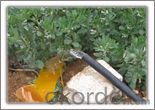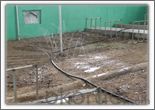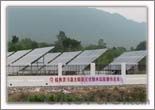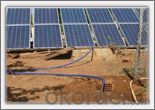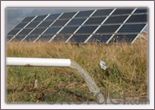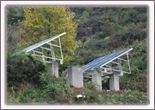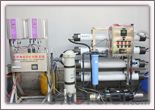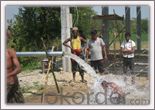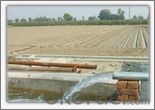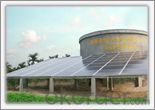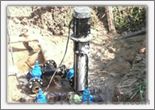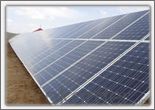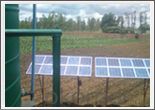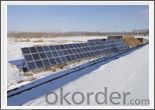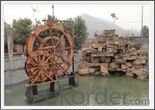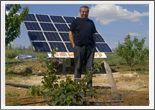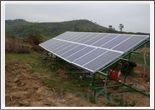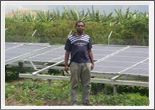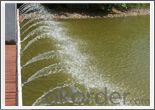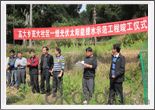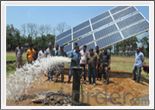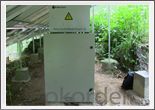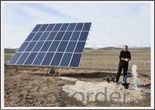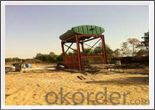PF Solar Pumping Inverter Water Pump Inverter
- Loading Port:
- Shekou
- Payment Terms:
- TT OR LC
- Min Order Qty:
- 20 set
- Supply Capability:
- 500000 set/month
OKorder Service Pledge
OKorder Financial Service
You Might Also Like
Solar Inverter Introduction:
Solar pumping inverter converts DC current from the solar array into AC current to drive the pump. With the function of MPPT (maximum power point tracking), it regulates the output frequency according to irradiation in real time to achieve the maximum power.
Solar Inverters Features:
1. Adopting the proposed dynamic VI maximum power point tracking (MPPT) control method; Fast response and stable operation; Better than the conventional methods which may lead to the problems including poor tracking performances, unstable or even cause water hammer damaging when the irradiation on the array changes rapidly.
2. The solar pumping inverters system is dispensed with energy storing devices, and stores water instead of electricity. It improves the reliability of the device, at the same time, it lowers the construction and maintenance costs of the system dramatically.
3. Digital control; automatic operation and data acquisition/storage of 8 years, etc; 98% of conversion efficiency, and complete protection.
4. In-line blocks; user friendly; convenient for operating; perfect cooling and shielding.
Solar Pumping Inverter Advantages:
1. To drive pumps equipped with 3-phase induction motors.
2. Optimized SPWM.
3. Various operation modes and MPPT algorithms are available.
4. Adjustable speed range of pump based on the actual situation of the system.
5. Available option of water-level detecting and control circuit.
6. Protection functions: lightning, over/low input voltage, over current and over load protection, etc.
7. Enclosure class: IP52.
8. Ambient temperature:-10~+50˚C.
Success Stories
►Middle East ►NaQu ►GuiLin
►Turkey ►XiNing ►YunNan
►Army stationed island ►Bangladesh ►Pakistan
►HaiNan ►HuBei ►Uganda
►XinJiang ►NingXia ►Afghan
►Zimbabwe ►Inner Mongolia ►Zhejiang
►Guangxi Guilin ►Turkey2 ►Botswana
►Naning ►Uganda ►Shaanxi
►Tsinghua University ►Pakistan ►Yunnan2
►FuJian ►Banqladesh ►YunNan3
►Turkey ►Inner Mongolia ►Senegal
- Q:Can a solar controller be used in marine applications?
- The utilization of a solar controller in marine applications is indeed feasible. A solar controller, also referred to as a charge controller, plays a vital role in regulating the flow of electricity from solar panels to batteries. Its main function is to ensure the efficient charging of batteries while preventing any potential damage caused by overcharging. In marine scenarios, where a dependable and efficient power source is often required, solar panels offer a commendable alternative to conventional sources like generators or shore power. By harnessing the sun's energy, solar panels have the ability to generate electricity, making them highly suitable for boats or yachts that frequently venture out to sea. To guarantee the proper charging of batteries and optimal performance of solar panels, the presence of a solar controller is crucial in marine applications. Not only does it safeguard the batteries from the risks associated with overcharging, such as decreased battery lifespan and potential safety hazards, but it also ensures that the solar panels are functioning at their best. Moreover, modern solar controllers are specifically designed to endure the rigorous marine environment, which includes exposure to saltwater, humidity, and vibrations. They are typically constructed using corrosion-resistant materials and possess waterproof or weatherproof ratings to withstand these challenging conditions. To summarize, a solar controller can be effectively and safely utilized in marine applications, offering a reliable and environmentally friendly power source for boats, yachts, and other marine vessels.
- Q:Can a solar controller be used in a solar-powered electric train system?
- Yes, a solar controller can be used in a solar-powered electric train system. A solar controller is responsible for regulating and controlling the flow of electricity between the solar panels and the batteries. In a solar-powered electric train system, the solar controller would ensure that the energy generated by the solar panels is efficiently stored and used to power the train's electric motors.
- Q:What are the advantages and disadvantages of a PWM solar controller?
- The advantages of a PWM solar controller include simple design and low cost, as well as efficient charging and maintenance of batteries. It also provides a constant voltage output, ensuring the battery is charged at an optimal level. However, PWM solar controllers have some limitations. They are less efficient than MPPT controllers, especially in low light conditions. Additionally, PWM controllers cannot convert excess voltage into usable energy, resulting in potential energy wastage.
- Q:What is the role of a solar controller in preventing battery sulfation?
- The role of a solar controller in preventing battery sulfation is to regulate the charging process of the battery and ensure that it is done efficiently and effectively. By monitoring the battery voltage and current, the solar controller can prevent overcharging, which is a major cause of battery sulfation. It also controls the charging rate to avoid undercharging, which can lead to sulfation as well. Overall, the solar controller plays a crucial role in maintaining the optimal charging conditions for the battery, thereby preventing sulfation and prolonging its lifespan.
- Q:How do you install a solar controller?
- To install a solar controller, start by determining the appropriate location near the solar panels where it will receive sufficient sunlight. Next, connect the solar panel's positive and negative leads to the controller's corresponding terminals. Then, connect the controller's battery terminals to the battery bank, ensuring correct polarity. Finally, connect any load or device to the controller's load terminals. Make sure to follow the manufacturer's instructions and safety guidelines throughout the installation process.
- Q:Can a solar controller be used with solar water heating systems?
- Yes, a solar controller can be used with solar water heating systems. The solar controller helps to regulate and control the flow of heat transfer fluid in the system, ensuring optimal performance and efficiency. It monitors and adjusts the temperature, ensuring that the water is heated to the desired level without overheating.
- Q:How does a solar controller prevent damage from power spikes?
- A solar controller prevents damage from power spikes by regulating and stabilizing the voltage and current output from the solar panels. It acts as a buffer between the panels and the battery or power grid, ensuring that only a safe and consistent amount of energy is transmitted. Additionally, the controller may incorporate surge protection mechanisms to divert or absorb any excessive voltage, safeguarding the system from harmful power spikes.
- Q:How does a solar controller handle load control and diversion charging?
- Load control and diversion charging are managed by a solar controller, which utilizes its built-in features and capabilities. To control the load, the controller offers multiple load terminals or outputs that can be connected to various electrical loads. This allows the controller to regulate the power flow and manage the energy consumption of each load, preventing system overload and ensuring efficient use of solar power. On the other hand, diversion charging involves redirecting surplus energy generated by the solar panels to charge additional devices or batteries. This is achieved by connecting a diversion load, such as a dump load or secondary battery bank, to the solar controller. When the connected loads require less energy than what is being produced, the excess power is diverted to the diversion load, preventing overcharging of batteries and maximizing solar energy utilization. Sophisticated algorithms and monitoring systems are commonly employed by solar controllers to determine when to activate load control or diversion charging. These algorithms take factors like battery voltage, solar panel output, and load requirements into consideration to make intelligent decisions regarding power distribution and diversion. Some controllers even utilize advanced MPPT technology to optimize solar panel output and ensure efficient power conversion. In conclusion, a solar controller effectively manages load control and diversion charging by providing multiple load terminals for power distribution and redirecting excess energy to a diversion load. It utilizes algorithms and monitoring systems to make intelligent decisions and optimize the utilization of solar energy.
- Q:Can a solar controller be used with different types of solar panel cleaning systems?
- Different types of solar panel cleaning systems can be used with a solar controller. The solar controller is responsible for regulating and optimizing the charging and discharging of batteries in a solar power system. Its purpose is to ensure efficient and safe charging of batteries by controlling the flow of electricity from the solar panels. The functioning of the solar controller is not directly affected by the type of solar panel cleaning system used. Its main role is to manage the flow of electricity, and it does not have any specific compatibility requirements with different cleaning systems. However, it is important to consider the compatibility of the solar controller with the overall solar power system and the specific cleaning system being used. The controller should be capable of handling the voltage and current requirements of both the solar panels and the cleaning system. It is advisable to refer to the manufacturer's specifications and guidelines to ensure that the solar controller is suitable for the specific cleaning system being utilized.
- Q:What is the role of a solar controller in preventing damage to the solar panels from fire hazards?
- Solar controllers, also known as charge controllers or solar regulators, are indispensable components in solar power systems. Their primary responsibility is to monitor and regulate the electrical flow between the solar panels and the battery system to safeguard against fire hazards and potential damage. To prevent overcharging and protect the battery bank, solar controllers regulate the voltage and current emanating from the solar panels. Their crucial role in fire hazard prevention lies in preventing the panels from generating excessive electricity. Overcharging a battery can lead to the emission of highly flammable hydrogen gas, which can result in fires or explosions. To address this risk, solar controllers diligently monitor the battery voltage and adjust the charging current accordingly. They incorporate safety mechanisms such as temperature sensors and voltage cut-off systems that effectively mitigate potential fire hazards. Should the battery reach its optimal charge or surpass a specified temperature threshold, the solar controller will automatically reduce or cease the charging current to prevent overcharging and the associated fire risks. Moreover, advanced solar controllers offer additional safety features including short-circuit protection, reverse current protection, and over-discharge protection. These features provide additional safeguards against electrical faults or abnormal conditions that might otherwise cause damage to the solar panels and potentially trigger fires. In essence, the role of a solar controller in preventing fire hazards and damage to solar panels involves regulating the flow of electricity, preventing overcharging and excessive discharge of the battery, and ensuring the safe operation of the entire solar power system. By effectively managing the electrical flow, solar controllers significantly diminish the risk of fire hazards, thereby ensuring the long-term durability and safety of the solar panels.
1. Manufacturer Overview |
|
|---|---|
| Location | |
| Year Established | |
| Annual Output Value | |
| Main Markets | |
| Company Certifications | |
2. Manufacturer Certificates |
|
|---|---|
| a) Certification Name | |
| Range | |
| Reference | |
| Validity Period | |
3. Manufacturer Capability |
|
|---|---|
| a)Trade Capacity | |
| Nearest Port | |
| Export Percentage | |
| No.of Employees in Trade Department | |
| Language Spoken: | |
| b)Factory Information | |
| Factory Size: | |
| No. of Production Lines | |
| Contract Manufacturing | |
| Product Price Range | |
Send your message to us
PF Solar Pumping Inverter Water Pump Inverter
- Loading Port:
- Shekou
- Payment Terms:
- TT OR LC
- Min Order Qty:
- 20 set
- Supply Capability:
- 500000 set/month
OKorder Service Pledge
OKorder Financial Service
Similar products
New products
Hot products
Hot Searches
Related keywords













